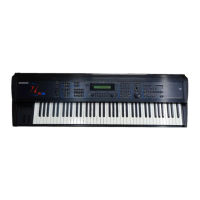Chapter 1ÑWelcome
ENSONIQ ZR-76 Musician's Manual 15
sections in the order youÕd like them to be heard, regardless of the order in which they were recorded.
When youÕre done experimenting with different structures, youÕll have created a new song.
Chapter 7ÑRecording details the workings of the Song Editor.
FF
FF
XX
XX
//
//
MM
MM
ii
ii
xx
xx
dd
dd
oo
oo
ww
ww
nn
nn
The ZR's FX/Mixdown facility allows you to add the final polish to your sounds, sequences and songs with
its comprehensive volume and stereo panning controls, and by providing access to the ZR's powerful 24-bit
effects (or FX). Each sound and sequence can take advantage of three types of effects:
¥ the insert effectÑeach sound in SoundFinder or sequence in the 16 Track Recorder can have one of
these exceptional effects; sounds in the 16 Track Recorder use the sequenceÕs insert effect
¥ a Global ChorusÑeach song has its own high-quality digital chorus effect that can be used by
SoundFinder sounds, or by 16 Track Recorder sounds
¥ a Global ReverbÑeach song has its own high-quality digital reverb effect that can be used by
SoundFinder sounds, or by 16 Track Recorder sounds
¥ dryÑmany of the ZR-76 sounds sound terrific without any effect at all
The effects are applied by sending each sound or 16 Track Recorder track to an effect bus, or FX Bus.
There are six effect busses:
¥ the Insert FX Bus
¥ the Chorus FX Bus
¥ the LightReverb FX Bus
¥ the MediumReverb FX Bus
¥ the WetReverb
¥ the Dry FX Bus (sounds using this bus are un-effected)
Each FX bus has its own settings that determine how it will use the effect (or effects) it can access, as well
as which rear-panel outputs it will ultimately utilize.
The ZRÕs FX/Mixdown section also provides muting and soloing options for isolating individual tracks or
groups of tracks in the 16 Track Recorder.
Chapter 8ÑFX/Mixdown provides a complete description of the ZRÕs FX/Mixdown facility and the ZR-76
effects.
TT
TT
hh
hh
ee
ee
ZZ
ZZ
RR
RR
--
--
77
77
66
66
MM
MM
ee
ee
mm
mm
oo
oo
rr
rr
yy
yy
aa
aa
nn
nn
dd
dd
SS
SS
tt
tt
oo
oo
rr
rr
aa
aa
gg
gg
ee
ee
The ZRÕs memory is divided into two general categories:
¥ ROM for ÒRead Only MemoryÓÑpermanent, un-erasable memory that holds sounds, rhythms and
presets created by ENSONIQ
¥ INT for ÒInternalÓÑwritable memory that you can use to store your own sounds, rhythms, presets,
sequences and songs
The INT memory itself contains two different types of memory:
¥ FLASHÑmemory which remains in your ZR-76 even when you power off. In addition to holding all of
your system-wide settings, FLASH makes an ideal place to store sounds, rhythms and presets that
youÕll always want to have on hand as creation and performance tools.
¥ RAMÑshort for ÒDRAMÓÑan area of memory useful for holding items that youÕll only need for a
particular work session. When you turn your ZR-76 off, RAM memory is cleared of its contents. The
Idea Pad and the 16 Track Recorder share this type of memory with RAM sound and rhythm banks.
The ZRÕs librarian allows you to perform a number of memory management tasks that allow you to get the
most out of your ZR-76. Using the librarian, you can, among other things, configure your INT memory to
suit your purposes, keep track of your FLASH and RAM memory usage and initiate various kinds of MIDI
System Exclusive data transmissions.
Your ZR-76 has a built-in high-density floppy disk drive (it can also read double-density disks) so you can
save your work to floppy disks. Sounds, rhythms, presets, sequences and songs can be easily saved to
disk.
As a convenience, the ZR-76 Save LED will flash when youÕve got a sound, preset, rhythm or sequence in
RAM that hasnÕt yet been stored on a floppy disk for safekeeping.

